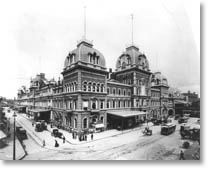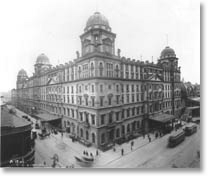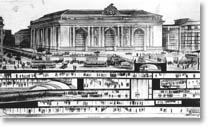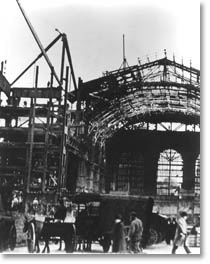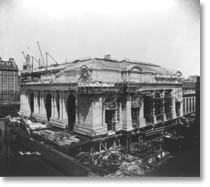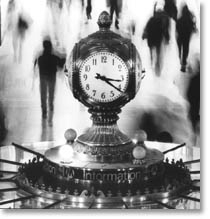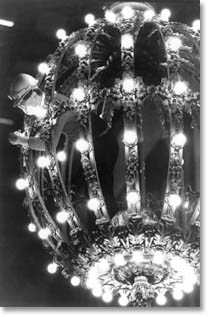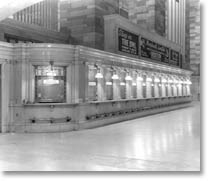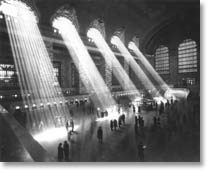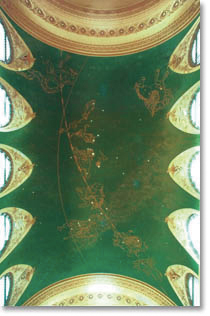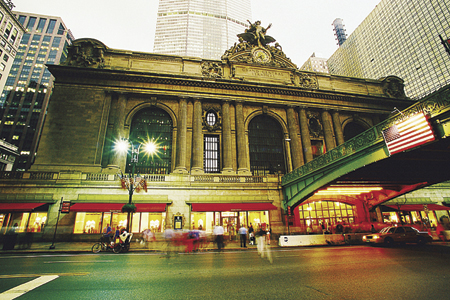THE HISTORY OF GRAND CENTRAL TERMINAL
The Advent of the Railroad in New York City
Imagine Park Avenue from 45th to 49th Street as a rail yard, a corridor of smoke and cinders extending uptown from 49th Street. Think of breweries and factories operating where the Waldorf Astoria, Lever House and the Seagram Building now stand. Picture to the east a district of tenements, warehouses, and slaughterhouses. In place of the United Nations and Tudor City the squatters’ shacks of Dutch Hill, inhabited by paupers, criminal gangs, and a herd of goats. It is hard to conceive that this cityscape ever existed, let alone that it was the environment in which Grand Central Terminal took shape less than one hundred years ago.While Grand Central Terminal stands today as one of New York City’s most famous landmarks it was by no means the first railroad station in New York City. In fact, the current structure is neither the first to claim the name “Grand Central” or to occupy the present location at 42nd and Park. Yet, the story of Grand Central Terminal allows one to gaze back and observe much of the history of the City of New York, and to witness the growth and expansion of a vibrant metropolis reflected in an unrivaled monument of civic architecture.
The first rail line into New York City, the New York and Harlem Railroad, was formed in 1831 and began service to a terminus at Fourth Avenue and 23rd Street the following year.
Over the next five years, the railroad constructed a station, offices, and stables along Fourth Avenue, 26th and 27th Streets. Through subsequent expansion and reconstruction, the New York and Harlem Railroad Station would come to occupy the entire block bounded by Fourth and Madison Avenues and 26th and 27th Streets. In 1871, P.T. Barnum purchased the New York and Harlem Railroad Station and converted it into Madison Square Garden, the first of several structures to bear that historic name.
During the late 1840’s, additional railroad service into New York, notably The New York and New Haven Railroad and The Hudson River Railroad, precipitated the advent of variety of terminals, depots, freight houses and passenger stations throughout the city. Horse drawn extensions merged with steam powered lines in a haphazard network of railways that was plagued by complaints about noise, pollution, traffic, and chronic accidents. By 1858, steam locomotives had been progressively banned from crowded areas and were no longer in service below 42nd Street giving rise to the need for a new terminal.
The “Commodore” Creates Grand Central Depot
Shipping magnate “Commodore” Cornelius Vanderbilt acquired the Hudson River Railroad in 1864. Soon after, Vanderbilt added the New York Central Railroad to his holdings and consolidated his position by creating a rail link between Spuyten Duyvil and Mott Haven, allowing Hudson River trains to arrive at a common East Side terminal. In 1869, Vanderbilt purchased property between 42nd and 48th Streets, Lexington and Madison Avenue for construction of a new train depot and rail yard. On this site would rise the first Grand Central.Grand Central Depot, designed by architect John B. Snook, was built at a cost of $6.4 million and opened in October 1871. Virtually obsolete at the time it opened it served three distinct rail lines, the New York Central and Hudson River Railroad, New York and Harlem Railroad, and the New York, New Haven, and Hartford Railroad, each of which maintained its own waiting room, baggage facilities and ticketing operation at the station. Subsequent renovations and enlargements culminated in the 1898 expansion of the depot under architect Bradford Lee Gilbert and further interior renovation in 1900 directed by Samuel Huckel, Jr.
There Once Was a Grand Central Station
Reborn as “Grand Central Station,” the reconfigured depot’s most prominent feature was undoubtedly its enormous train shed. Constructed of glass and steel, the 100-foot wide by 650 foot long structure rivaled the Eiffel Tower and Crystal Palace for primacy as the most dramatic engineering achievement of the 19th century. The updated station also featured a “classical” façade, a unified 16,000 square foot waiting room, and distinctive ornamentation, including monumental cast iron eagles with wingspans of 13-feet. In fact, one of these eagles was recently salvaged and will rise again above Grand Central Terminal’s new entrance at 43rd Street and Lexington Avenue.All the while, the age of the steam locomotive was drawing to a close. Earlier efforts to increase safety and reduce congestion, including the Fourth Avenue Improvement Scheme which lowered tracks below grade from Grand Central Depot to 56th Street and created a tunnel from 56th Street to 96th Street, had proved insufficient. Noise and air pollution were chronic, and public concern about safety was on the rise.
A catastrophic train collision on January 8, 1902 in the smoke filled Park Avenue Tunnel killed seventeen and injured thirty eight causing a public outcry and increasing demand for electric trains. One week later, the New York Central and Hudson River Railroad announced plans to improve the Park Avenue Tunnel and expand Grand Central. By the end of the year, plans were in development spearheaded by the New York Central’s chief engineer William J. Wilgus to demolish the existing station and create a new double level terminal for electric trains.
The Creation of Grand Central Terminal
The plan was expensive. The railroad needed to invest in electrifying its rails, and carve deep into Manhattan’s bedrock (workers would ultimately excavate 2.8 million cubic yards of earth and rock). The solution to the projected $80 million project budget (roughly $2 billion in today’s terms) came from Wilgus as well.Without steam engines, there was no longer a need for an open rail yard. Wilgus proposed that the area from 45th to 49th Streets be paved over and that real estate developers be allowed to erect buildings over the concealed tracks. In exchange for this privilege, developers would pay a premium to the New York Central Railroad for “air rights.”
Construction in the years immediately after the completion of Grand Central Terminal would include apartment buildings like the Marguery, the Park Lane, and the Montana, and hotels including the Barclay, the Chatham, the Ambassador, the Roosevelt, and finally the Waldorf-Astoria, completed in 1931. (For many years, hydraulic tanks in the basement of Grand Central Terminal supplied power to these buildings).
In 1903, a select group of architects were invited to submit designs for the new Grand Central Terminal in a competition. Among them were McKim, Mead and White, architects of New York’s Pennsylvania Station (1910) and the adjacent General Post Office (1914), and D.H. Burnham and Company, chief planners of the 1893 Columbian Exposition in Chicago and architects of Washington D.C.’s Union Station (1907). The winning submission, however, was from the St. Paul firm of Reed and Stem. Reed and Stem had done other work for the New York Central and Reed’s sister was married to William Wilgus who by that time was the New York Central’s Vice President in charge of construction.
In spite of these connections, Reed and Stem could not have been ready for the end run that was about to occur. Subsequent to the competition, New York architects Warren and Wetmore presented the selection committee with their own proposal for the terminal. Warren, a cousin of New York Central Chairman William Vanderbilt, succeeded in his “appeal.”
In February 1904, Warren and Wetmore and Reed and Stem entered an agreement to act as The Associated Architects of Grand Central Terminal. The next six years would be spent reconciling, amending, and revising the plans for the new Grand Central.
Construction would last ten years. Excavation was an enormous undertaking as the grade of the rail yard was lowered to an average depth of 30 feet below street level. Yet, in spite of the upheaval, rail service continued uninterrupted. Initially, trains continued to use the old Grand Central which was eventually razed in 1910. A temporary station in the Grand Central Palace at Lexington Avenue and 43rd Street was used until 1912.
The Terminal Opens and Development Follows
Grand Central Terminal officially opened to great fanfare at 12:01 am on Sunday, February 2, 1913. More than 150,000 people visited the new terminal on its opening day. Although construction was not yet entirely complete, Grand Central Terminal had arrived and New York City would never be the same again.With Grand Central acting as an anchor, development around the terminal took off. Between 1913 and 1917, the Biltmore Hotel, the Yale Club, and two office buildings were constructed on railroad property across Vanderbilt Avenue.
During the 1920’s, as hotels and apartment buildings began to rise on the “air rights” tracts of Park Avenue, skyscrapers simultaneously sprang up along East 42nd Street. Warehouses gave way to the 56 story Chanin Building, the 54 story Lincoln Building and the 77 story Chrysler Building. On Lexington Avenue, the Hotel Commodore opened in 1919 and the Eastern Offices Building, better known as the Graybar Building, was completed in 1927, each with a passageway connection to Grand Central’s Main Concourse.
As the neighborhood prospered, so did Grand Central. At various times, Grand Central Terminal housed an art gallery, an art school, a newsreel movie theater, a rail history museum and innumerable temporary exhibitions. All the while, it remained the busiest train station in the country with a bustling Suburban Concourse on the lower level and famous long distance trains like the Fast Mail, the Water Level Limited, the Wolverine, and the Twentieth Century Limited departing from its Main Concourse. In 1947, over 65 million people, the equivalent of 40% of the population of the United States, traveled the rails via Grand Central Terminal.
Grand Central Declines
But Grand Central Terminal was about to fall victim to the same forces that originally enabled its construction. By the early 1950’s, as post war America transformed itself into a nation of suburbs and automobiles, revenues from long distance rail travel were plummeting. At the same time, the value of prime Midtown Manhattan real estate had risen dramatically. In 1954, the railroad resolved to make the most of its assets, commissioning plans to demolish Grand Central Terminal and replace it with a 6 million square foot office tower.Nothing came of this plan. But in 1958, the railroad concluded negotiations with developer Erwin S. Wolfson to demolish the six story office structure at the Terminal’s rear and replace it with the 59-story Pan Am Building. Completed in 1963, the Pan Am Building sealed off Park Avenue completely obscuring the Terminal from uptown. Concurrently, the interior of the terminal was being parceled out for billboards and commercial advertising in an on going effort to increase revenues.
Saved From the Wrecking Ball
On August 2, 1967, New York City’s recently established Landmarks Preservation Commission, formed in response to the demolition of Pennsylvania Station, designated Grand Central Terminal as a landmark subject to the protection of law. Apparently, this decision ensured the Terminal’s safety. The most serious threat, however, arose the following year.Penn Central, the resultant conglomerate of a merger between the New York Central and Pennsylvania Railroads, leased Grand Central Terminal to developer UGP Properties, Inc. in 1968. That same year UGP proposed building a 55 story tower designed by Marcel Breuer above Grand Central. The Terminal’s facade would have been preserved but rendered virtually invisible. The entire Main Waiting Room and part of the Main Concourse would have been demolished. When the Landmarks Preservation Commission refused to approve the scheme Breuer and UGP Properties presented a second proposal which would have saved the Main Concourse but demolished the facade. In August 1969, the Landmarks Preservation Commission again blocked the project.
Penn Central filed an $8 million lawsuit against the City of New York, essentially challenging the validity of the City’s landmarks law. Litigation lasted for nearly a decade. City leaders, including Jacqueline Kennedy Onassis and Brendan Gill, rallied against changes to Grand Central Terminal. In December 1976, the National Register of Historic Places named Grand Central Terminal as a National Historic Landmark. More importantly, the Penn Central lawsuit went all the way to the United States Supreme Court which on June 26, 1978, upheld New York’s landmark law in a decision written by Justice William J. Brennan for a six - three majority.
Grand Central had been spared the wrecking ball but was far from saved. After decades of deferred maintenance the building was crumbling. The roof leaked, stonework was chipping away, structural steel was rusted. Pollution and dirt had stained surfaces. Commercial intrusions, like the Kodak sign and the Newsweek clock, blocked out natural light.
New Hope for the Grand Old Building
In 1983, Metro North took over operation of Grand Central Terminal, and soon after the railroad began a systematic program of repairs and capital improvements, including a $4.5 million project to replace the leaking roof and skylights. This urgently needed work helped stabilize the building and enabled Metro North to develop a long term strategy for Grand Central.In 1988, Metro North commissioned a master revitalization plan from Beyer Blinder Belle, the architects responsible for the restoration of Ellis Island. Metro North then asked retail specialists Williams Jackson Ewing to prepare a master retail plan to address amenities and services in Grand Central. In April 1990, a $425 million Master Plan for Grand Central Terminal was presented at a public hearing and subsequently adopted in concept by the Metropolitan Transportation Authority. This significant decision was followed by an investment of $160 million in utility upgrades, Main Concourse improvements, and structural repairs. The former Main Waiting Room was also restored in accordance with the new Master Plan and was inaugurated as a public exhibition and special events space in 1992.
Restored, Rejuvenated, Rededicated
In 1994, the Metropolitan Transportation Authority gained long term control of Grand Central Terminal in the form of a 110 year lease from American Premier Underwriters, Inc., successor to the Penn Central Corporation. This enabled the MTA to enter into an agreement with GCT Venture, Inc., a partnership of developers LaSalle Partners Incorporated and Williams Jackson Ewing, to implement a comprehensive revitalization plan based on the Master Plan for Grand Central Terminal. Construction began in 1996 with the cleaning of the Main Concourse Sky Ceiling. As restoration and renovation continued, the project generated more than 2,000 construction and construction related jobs throughout New York State.The revitalization project culminated with a gala Rededication Celebration of Grand Central Terminal on October 1, 1998. This event garnered both national and international media attention and marked the beginning of a new chapter of this venerable New York City landmark.
Now, The Heart of New York City
Completely restored back to it’s 1913 splendor, Grand Central has become a midtown destination for five exquisite restaurants and cocktail lounges, 20 casual international eateries in the lower level Dining Concourse, gourmet foods from the Grand Central Market and the 50 unique specialty shops throughout the concourses, all in addition to transportation.
Grand Central has also transformed itself into a venue for ongoing public events. Throughout the year, Vanderbilt Hall, the Terminal’s 12,000 square foot former Main Waiting Room, is the site for ongoing free promotions and entertainment ranging from tennis exhibits to the annual Holiday Fair which brings 72 craftsmen, artisans and international importers to the Terminal selling an outstanding array of merchandise for holiday gifts.
Grand Central has become an international example of a successful urban project that gave new life to an historic building which otherwise would have been discarded and destroyed.
NAVIGATION: INDEX • ADVERTISER DIRECTORY • ARCHIVES •
• INDUSTRY TRADE ASSOCIATIONS • CONTACT •
COPYRIGHT © 2005 TLC MAGAZINE ONLINE, INC.

